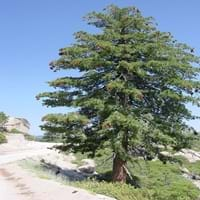Life Span
Perennial
Perennial
Type
Flowering Plants
Needled or Scaled Evergreen
Origin
Italy, Southern Europe, western Balkans
Western United States, Canada
Types
not available
Not Available
Habitat
Islands, Not Available
Woodland Garden Canopy
USDA Hardiness Zone
7-10
Not Available
Sunset Zone
21,22
Not Available
Habit
Upright/Erect
Oval or Rounded
Flower Color
Lavender, Light Blue, White
Non Flowering Plant
Flower Color Modifier
Bicolor
Bicolor
Fruit Color
Non Fruiting Plant
Brown, Sandy Brown
Leaf Color in Spring
Green, Light Green
Not Available
Leaf Color in Summer
Green, Light Green
Not Available
Leaf Color in Fall
Green, Light Green
Not Available
Leaf Color in Winter
Light Green
Not Available
Leaf Shape
Compound
Needle like
Plant Season
Summer, Fall
Spring, Summer, Fall, Winter
Sunlight
Full Sun, Partial Sun
Full Sun
Growth Rate
Medium
Medium
The pH of Soil
Acidic, Neutral
Acidic, Neutral
Soil Drainage
Average
Well drained
Bloom Time
Early Summer, Summer, Late Summer
Not Available
Tolerances
Heat Tolerance
Drought
Where to Plant?
Ground, Pot
Ground
How to Plant?
From bulbs, Seedlings, Stem Planting
Cuttings, Seedlings
Plant Maintenance
Low
Medium
Watering Requirements
Average Water Needs, Do Not over Water, Never Over-water, Requires regular watering
Water three times weekly in summer
In Summer
Lots of watering
Lots of watering
In Spring
Moderate
Moderate
In Winter
Average Water
Average Water
Soil pH
Acidic, Neutral
Acidic, Neutral
Soil Drainage Capacity
Average
Well drained
Sun Exposure
Full Sun, Partial Sun
Full Sun
Pruning
Remove damaged leaves, Remove dead branches, Remove dead leaves, Remove dead or diseased plant parts
Remove damaged leaves, Remove dead branches, Remove dead leaves
Fertilizers
fertilize every 2-3 weeks while growing, fertilize in growing season
27-3-3 ratio, Requires high amount of nitrogen
Pests and Diseases
fungus
Blister Rust
Plant Tolerance
Drought, Heat Tolerance
Drought
Flower Petal Number
Single
Single
Showy Foliage
Not Available
No
Foliage Texture
Not Available
Not Available
Foliage Sheen
Not Available
Glossy
Attracts
Birds, Insects
Douglas squirrels, Owls
Allergy
Toxic
Skin irritation
Aesthetic Uses
Beautification, Landscape Designing, Showy Purposes
Not Used For Aesthetic Purpose
Beauty Benefits
Not Available
Not Available
Environmental Uses
Air purification
Air purification
Medicinal Uses
Asthma, Cough, Unknown
Carminative, Laxative, Opthalmic, Poultice
Part of Plant Used
Flowers, Leaves
Seeds, Wood
Other Uses
Decoration Purposes, Showy Purposes, Used as Ornamental plant
Adhesive, Used as a chewing gum, Used for making green dye, Vanillin flavouring is obtained as a by-product
Used As Indoor Plant
Yes
No
Used As Outdoor Plant
Yes
Yes
Garden Design
Mixed Border, Wildflower
Feature Plant
Botanical Name
CAMPANULA pyramidalis
PINUS lambertiana
Common Name
Chimney Bellflower
Sugar pine, Sugar cone pine
In Hindi
Chimney Bellflower
Sugar Pine
In German
Schornstein Glockenblume
Sugar Pine
In French
cheminée Bellflower
Sugar Pine
In Spanish
Chimenea Bellflower
Sugar Pine
In Greek
καμινάδα καμπανούλα
Sugar Pine
In Portuguese
chaminé Bellflower
Sugar Pine
In Polish
komin Bellflower
Sugar Pine
In Latin
caminorum purgatores Bellflower
Pinus
Phylum
Tracheophyta
Coniferophyta
Class
Magnoliopsida
Pinopsida
Family
Campanulaceae
Pinaceae
Clade
Angiosperms, Asterids, Eudicots
Not Available
Tribe
Not Available
Not Available
Subfamily
Not Available
Pinoideae
Number of Species
Not Available
Not Available
Difference Between Chimney Bellflower and Sugar Pine
If you are confused whether Chimney Bellflower or Sugar Pine are same, here are some features about those plants to help you choose better. Many people think that these two plants have the same characteristics, but one can see Chimney Bellflower and Sugar Pine Information and learn more about it. Fertilizers required for proper growth of Chimney Bellflower are fertilize every 2-3 weeks while growing and fertilize in growing season, whereas for Sugar Pine fertilizers required are 27-3-3 ratio and Requires high amount of nitrogen. Hence, one should know the basic difference between Chimney Bellflower and Sugar Pine if you are planning to have them in your garden to enhance its beauty.
<
Flowering PlantsImportance of Chimney Bellflower and Sugar Pine
Want to have the most appropriate plant for your garden? You might want to know the importance of Chimney Bellflower and Sugar Pine. Basically, these two plants vary in many aspects. Compare Chimney Bellflower and Sugar Pine as they differ in many characteristics such as their life, care, benefits, facts, etc. Every gardener must at least have the slightest clue about the plants he wants to plant in his garden. Compare their benefits, which differ in many ways like facts and uses. The medicinal use of Chimney Bellflower is Asthma, Cough and Unknown whereas of Sugar Pine is Carminative, Laxative, Opthalmic and Poultice. Chimney Bellflower has beauty benefits as follows: Not Available while Sugar Pine has beauty benefits as follows: Not Available.
Compare Facts of Chimney Bellflower vs Sugar Pine
How to choose the best garden plant for your garden depending upon its facts? Here garden plant comparison will help you to solve this query. Compare the facts of Chimney Bellflower vs Sugar Pine and know which one to choose. As garden plants have benefits and other uses, allergy is also a major drawback of plants for some people. Allergic reactions of Chimney Bellflower are Toxic whereas of Sugar Pine have Skin irritation respectively. Having a fruit bearing plant in your garden can be a plus point of your garden. Chimney Bellflower has no showy fruits and Sugar Pine has showy fruits. Also Chimney Bellflower is not flowering and Sugar Pine is not flowering . You can compare Chimney Bellflower and Sugar Pine facts and facts of other plants too.





